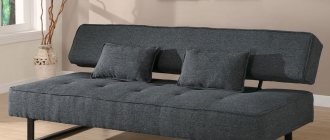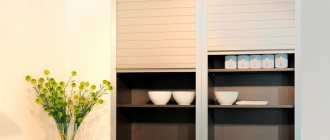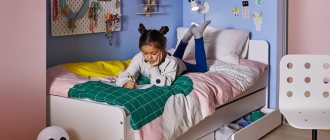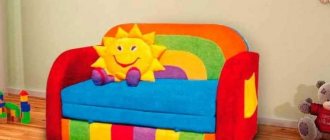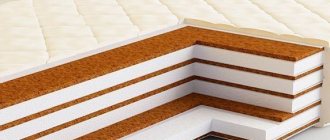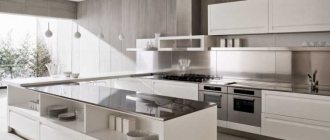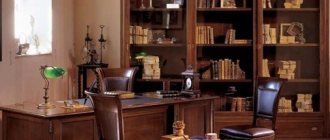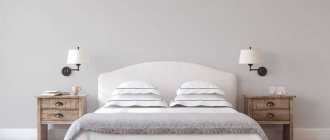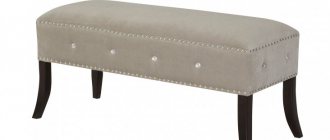36393
A modern alternative to classic wooden or wood-based furniture is a fabric cabinet, which is lightweight, compact, and easy to install and maintain. Such furniture retains the functions of a standard cabinet, in addition, it has a number of advantages compared to traditional furniture.
Purpose
A fabric cabinet is intended for the same purposes as a regular one, made from standard materials: wood, chipboard, MDF, plastic. Its purpose is to store clothes, textiles, toys, shoes, office papers, books, magazines, small items for the home, dishes, seasonal items, and household supplies.
The purpose of such a piece of furniture is determined based on its “filling”. The presence of a crossbar with shelves means that the wardrobe is a wardrobe. Shelves and bright patterns make it a convenient storage area for toys in the nursery. A strict appearance, laconic compartments are an option for storing books or papers.
The main difference between a fabric closet and a regular one is that it is most often used as a mobile, temporary option. It is used in rented housing, with frequent moves, in the country, during renovations, in a student dormitory, in a children's room, where children will soon grow up and need completely different furniture. This fabric cabinet is easy to disassemble and transport from place to place.
A variety of colors, shapes and options allows you to organically fit a fabric wardrobe into almost any interior. But most people still prefer stationary cabinets for a permanent apartment. Therefore, the fabric option is primarily considered temporary.
DIY textile cabinet made from plastic bottles
This is another option for sewing fabric shelves with your own hands. Sometimes, having bought an expensive plastic wardrobe, we may find that our clothes or shoes do not fit there, and in order to do this, we have to deform our personal belongings. But why make such sacrifices when there is another way out of the situation - shelves made of large plastic bottles. These shelves are very convenient to use. Their depth allows you to store a lot of things and other items. Let's get acquainted with a step-by-step master class on making shelves from fabric and plastic bottles.
For work we will need:
- Fabric in two colors measuring 1m x 60 cm.
- Plastic 5 liter flasks.
- Threads to match the fabric or contrast.
- Centimeter.
- Scissors.
- Double sided tape.
Important! Don't be upset if you don't have double-sided tape. It can be quickly made from ordinary ones. How? We will now tell you about this in step-by-step instructions:
- Place a strip of regular tape on the edge of the table. The main rule is that the table surface must be dry and clean. The tape should extend onto the table no more than 1 cm along the entire length of the sticky side. We leave the steel part of the tape hanging freely in the air.
- We take the free, un-glued edge of the tape and with the sticky side out, wrap it, gluing the free edge to the edge that we glued to the table.
- Carefully remove the resulting twist and cut it into pieces of the length we need.
Homemade double-sided tape is ready! It holds perfectly and is practically invisible when connecting plastic bottles and more.
We sew fabric shelves
Now let's look at a master class on creating a fabric wardrobe:
- We started by taking three 5-liter bottles and cutting off their upper part, which is tapered. We need to cut diagonally so that when connecting we get one angle of inclination.
- Using double-sided tape, glue the plastic bottles together as tightly as possible, keeping the same cut line.
- We begin to sew a contour cover for our shelves, which will decorate our homemade design. The case will consist of an outer and an inner side, since we took transparent plastic bottles.
Important! If you find colored flasks of this volume, then it is not necessary to make the inside.
- We cut out the outer and inner parts according to the same pattern: one middle part and two side ones. The width of the central part is equal to the width of the bottom of the plastic shelves, and the length is the distance from the edge of the top shelf to the bottom of the bottom one.
- The pattern of the sides is very simple. We place the connected plastic shelves on the fabric and trace their outline. The result is a rectangular parallelepiped, which will become our sidewalls.
Important! Don't forget to allow a few centimeters of seam allowance.
- We connect the top parts and the lining parts. Iron the seams. We put the lining inside the outer part of the cover and, using an iron, prepare them for the connecting seam. Try to iron the hem so that the top of it extends 0.5 cm beyond the inner hem. This way we will create an edging around the entire perimeter of our cover.
We really hope that our article helped you sew a textile wardrobe with your own hands. We brought to your attention the best lessons on how to create such a wonderful design. Let peace, order and harmony always reign in your home!
Very simple! Such furniture can be assembled in an evening even by those who have never held a hammer in their hands. A few hours of work, and your home will have a stylish wardrobe from the cover of a fashion design magazine.
You can strictly follow our instructions, or you can choose your own sizes, add more shelves, hooks, and even hang cabinet doors on hinges. True, this will be a completely different model!
Advantages and disadvantages
A temporary or permanent fabric cabinet has many advantages over classic wood or slab furniture. Its main advantages:
- ease of assembly and disassembly - even a fragile girl or teenager can handle it without special tools and equipment;
- compactness, low weight when disassembled - easy to transport from place to place in a regular suitcase, it weighs several kilograms;
- a variety of colors, patterns, designs - thanks to this you can choose an option for any room;
- ease of care - the fabric cover can be washed in a regular machine without losing its appearance;
- convenience, versatility - textile cabinets are used to store a wide variety of things, and the presence of external pockets makes it even more practical;
- protection of things from light, moisture, dust - the cabinet is usually closed with a zipper or Velcro, and its fabric does not allow moisture to pass through;
- ease of movement - even when assembled it weighs little, one person can move it from place to place;
- low cost - compared to stationary ones, the fabric version costs mere pennies.
It also has disadvantages. For example, a textile cabinet will not fit into every interior; it will not be able to emphasize the status and wealth of the owners.
It is enough to periodically wipe off dust from an ordinary cabinet, and spills on it can be easily wiped off, but a fabric one will have to be washed. Usually covers have dust-repellent properties, but over time it still accumulates.
In order to make a cabinet with your own hands, you will need.
Order cutting plywood 2 cm thick:
- 50 cm x 180 cm - for side walls - 2 parts;
- 50 cm x 90 cm - for shelf, top and bottom - 3 parts;
- 30 cm x 180 cm - for the back wall - 1 piece;
- copper or chrome pipe;
- wood screws;
- round mirror with a diameter of 20 cm (optional);
- pipe cutter (or ask to cut the pipe immediately in the store);
- electric drill and drill bits;
- grinder or sandpaper;
- screwdriver;
- construction tape;
- ruler.
Varieties
There are as many varieties of fabric wardrobes as there are for a regular one. The following varieties are popular:
- wardrobe - the most common option for a fabric wardrobe. It is represented either by a compartment with a crossbar for hangers, or the classic version - a department with a crossbar plus compartments with shelves for storing bed linen, towels, knitwear, bedding, underwear;
- cabinet rack - its contents are represented only by shelves. This variety can be adapted for various purposes: storing textiles, books, papers, kitchen utensils and other things;
- for a child’s room - can be used both for storing toys only and for children’s clothes, toys, and linen. Options for children's rooms have bright colors, convenient shelves, drawers, external pockets, drawings with favorite children's characters;
- for shoes - this is a convenient option for the hallway or for storing seasonal shoes. The material from which such storage facilities are made is impregnated with a special composition that repels water and dirt.
Clothes
For children's
For shoes
Rack
There are different types of cabinets based on the closing method:
- with a zipper;
- Velcro;
- with ties;
- with curtains;
- completely open.
It’s a matter of taste, but the zippered option is the most airtight and reliably protects against the penetration of dust, dirt, and moisture. It will protect seasonal clothing and shoes well. Options with curtains or ties look cozy in the interior of a dacha or summer house, especially if you choose colors in the Provence style. It will be easier for children to manage cabinets with Velcro or completely open ones - especially when it comes to storing toys.
When purchasing a textile piece of furniture for a nursery, choose an option with good water and dirt-repellent impregnation. A good option would be a model with many decorative elements and bright details. The child will enjoy arranging things on his own, and additional elements will help develop fine motor skills and tactile abilities.
Open
Velcro
With a zipper
With curtains
Types of folding fabric cabinets - purpose
<
>
Types of fabric cabinets by type of purpose:
- wardrobe is the most popular option. With dimensions of 175 cm by 140 cm, the cabinet weighs only 6 kg. It captivates with its spaciousness and functional interior contents. The section with a bar will fit a lot of clothes on hangers. Towels and bed linen will take their place on small shelves or a spacious mezzanine. There will also be baskets with underwear and other small items;
- a shelving unit or bookcase is an excellent option for the living room. Placed near an armchair or sofa. Fill it to your liking: magazines, books or frames with photos, crafts, applications. You can also combine both options, creating a practical and decorative area. A fabric rack is also placed in the bathroom, filling the shelves with towels, replacement robes, and other bath accessories;
- For a children's room, cabinets of brighter colors, with drawings and images of fairy-tale characters are selected. External pockets and shelves with baskets will especially please your child. For comfortable wet cleaning in the nursery, it is recommended to choose a model with wheels;
- It is better to buy a folding shoe cabinet in bright or dark colors. Manufacturers claim that these models are distinguished by material impregnated with a special agent. Dirt and moisture are not absorbed into the fabric, fresh stains are easily removed. Despite this, for a long service life of the cabinet, it is recommended to place clean, dry shoes on the shelves. Models with 8 shelves are spacious, measuring about 140 cm in height and 60 cm in width. Moreover, the entire structure weighs only 3 kg.
Manufacturing materials
As the name of this piece of furniture suggests, the main material for its manufacture is fabric. Special synthetic materials are also used that have high strength, density and are impregnated with special compounds in order to keep moisture out and repel dust and dirt.
The fabric must also have certain properties:
- do not burn out in the sun;
- do not wrinkle when washing;
- do not shed;
- do not leave streaks or stains;
- be dense enough to support different weights.
Everything is clear with fabric, but the basis of the structure is a rigid frame onto which the textile cover is stretched. For its manufacture, hollow, lightweight metal tubes, metal-plastic or simply thick plastic are used. During assembly, the tubes are fastened together with plastic connecting elements. The legs of the structure end either with wheels for ease of movement, or with rubber pads so as not to scratch the floor.
Crossbars for hangers, bases of shelves, drawers are made from the same tubes as the frame, or tubes of a different diameter. In addition, this item is equipped with metal or plastic elements for closing - a base for the curtain, Velcro, zippers, hooks, and so on.
Rules for selection and placement
When choosing a fabric wardrobe, first of all you need to be guided by the same principles as when choosing a regular one. What things do you plan to store in it? What is the volume of things? Where will it be located? All these questions should be taken into account when purchasing unusual furniture.
In addition, an important point is the selection based on the interior features, because even if it is a rented apartment, you still want it to be beautiful and cozy.
The most popular option is a bedroom closet. It will store dresses and suits, bed linen, home clothes, bedding, and intimate wardrobe items. Therefore, when choosing this option, you should pay attention to its capacity. The wardrobe is updated regularly, so even if there are few things now, there may soon be more. This means that you need to choose “with reserve”. You should also make sure that the storage area has a crossbar for hangers and a compartment with shelves. This is a classic, and therefore a win-win option.
When choosing a shoe cabinet, you need to pay special attention to the fabric from which it is made. It should be durable, non-marking, easy to clean, and waterproof. Metal parts must be protected from moisture and stainless. Also, the closet should fit harmoniously into the interior of the hallway.
If the closet is used for temporary storage of seasonal shoes, put away for the winter or summer, and therefore clean and dry, then the fabric can be almost any. The main thing is that it closes tightly with a zipper. Then neither dust nor moths will reach your winter boots. For additional protection against the latter, it is worth putting special means inside.
Wardrobes for children's rooms are usually used to store toys and various little things that the child needs - a kind of large pencil case. This is real space for imagination in terms of shapes, sizes, designs, colors. However, when choosing furniture for children, you should give preference to non-staining, easily washable fabric, perhaps with a pattern on which various marks will not be so noticeable. Older children treat things more responsibly, so when choosing for them, you can only be guided by the child’s personal preferences.
Fabric for making furniture, as a rule, does not allow water to pass through well. However, this is still fabric, not film, not plastic. Therefore, it is better to place such furniture away from water. A bathroom with high humidity is unlikely to be a wise place for a fabric cabinet. Also, you should not place it next to heating appliances, stoves, or heaters. And although all manufacturers claim that the fabric does not fade in the sun, you should still not place the structure in direct sunlight.
How to care
The materials from which the fabric cabinet is made have a special density, strength, and are also treated with a composition that repels dust, water, and dirt. However, dust, albeit slowly, still accumulates, and pollution - especially if there are small children or animals in the house - is inevitable. Therefore, the fabric from which the cover is made must be washed periodically. To do this, it must be easily removed from the frame. Washing is done in a regular washing machine with standard detergents, unless otherwise specified in the product instructions.
To prevent the accumulation of dust, you can treat the surface of the furniture with special antistatic sprays during cleaning, and brush off the dust itself with a broom. Many fresh stains are easy to remove immediately. After the time is up, all that's left is the wash.
You should also keep under control the condition of the frame tubes and connecting elements. Avoid breaking or damaging them, and do not place more things inside than the weight of the structure can support.
Generally speaking, a textile cabinet is an excellent alternative to traditional bulky furniture. Easy to install and maintain, stylish, bright, roomy, it can find its place in every home.
Nuances of care
A feature that every fabric cabinet has is easy disassembly. If cleaning is necessary, the fabric can be removed from the frame without unnecessary complications. Wash the material once or twice a year or when soiled. Despite the processing and impregnation of the fabric, it still gets dirty over time and accumulates dust. Washing is carried out manually or using a conventional machine, which depends on the characteristics of the fabric.
Scope of application of computer cabinets, main models and their features
Regular care involves cleaning the furniture from dust. To prevent it from accumulating on fabric surfaces, they are treated with an antistatic agent. It is better to remove dirt immediately, otherwise there is a risk that they will remain after washing.
It is important to monitor the integrity of the frame, connecting parts, and fasteners. If corrosion appears, treatment should be carried out; if it becomes loose, loose connections should be tightened. You cannot put things inside that are too heavy, exceeding the permissible weight, as this will quickly damage the furniture.
With proper care, a fabric wardrobe will last for many years. This is an excellent option for those who like to move, residents of rented housing, students, and summer residents. And also all those who value practical, multifunctional and unusual things.
